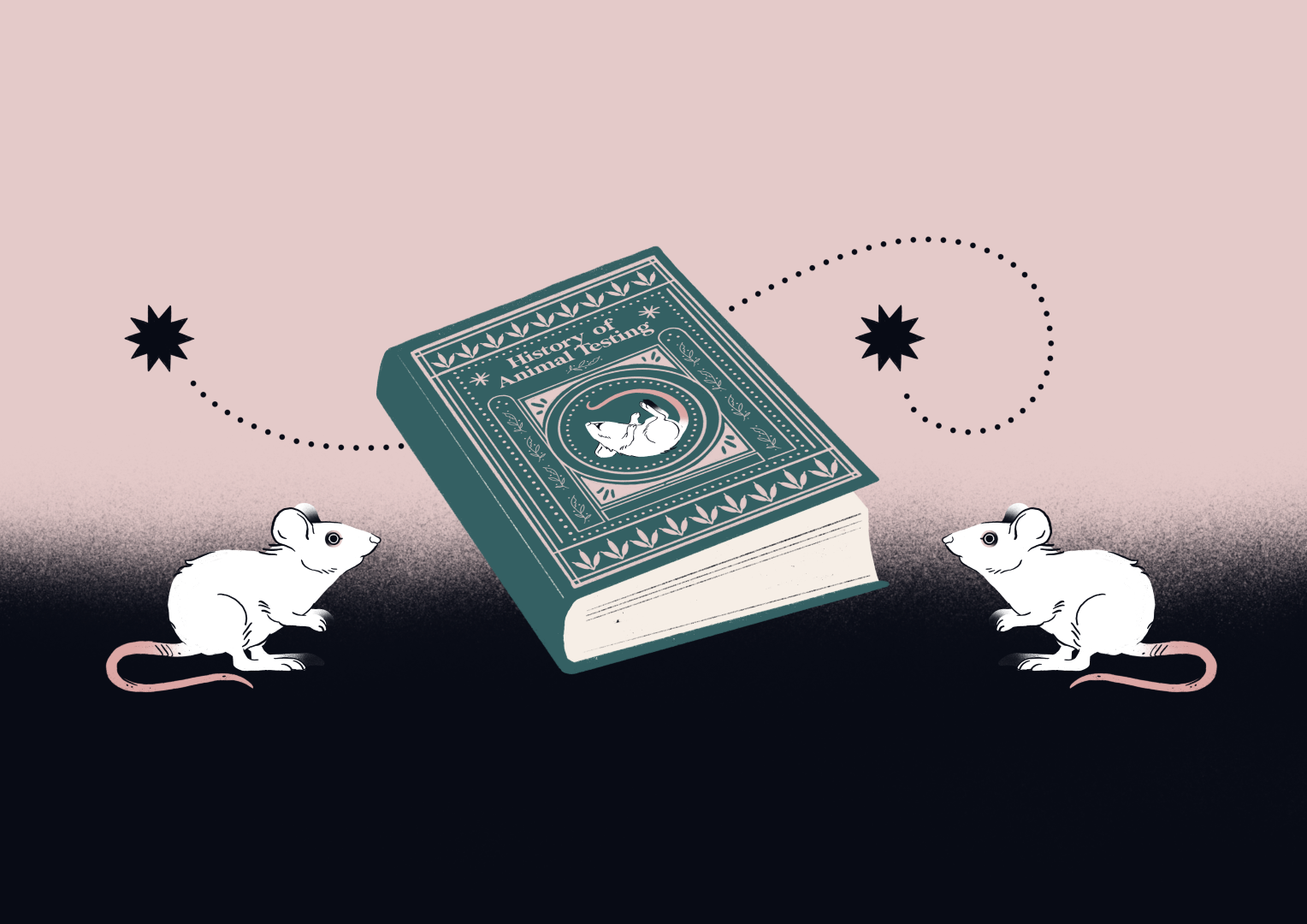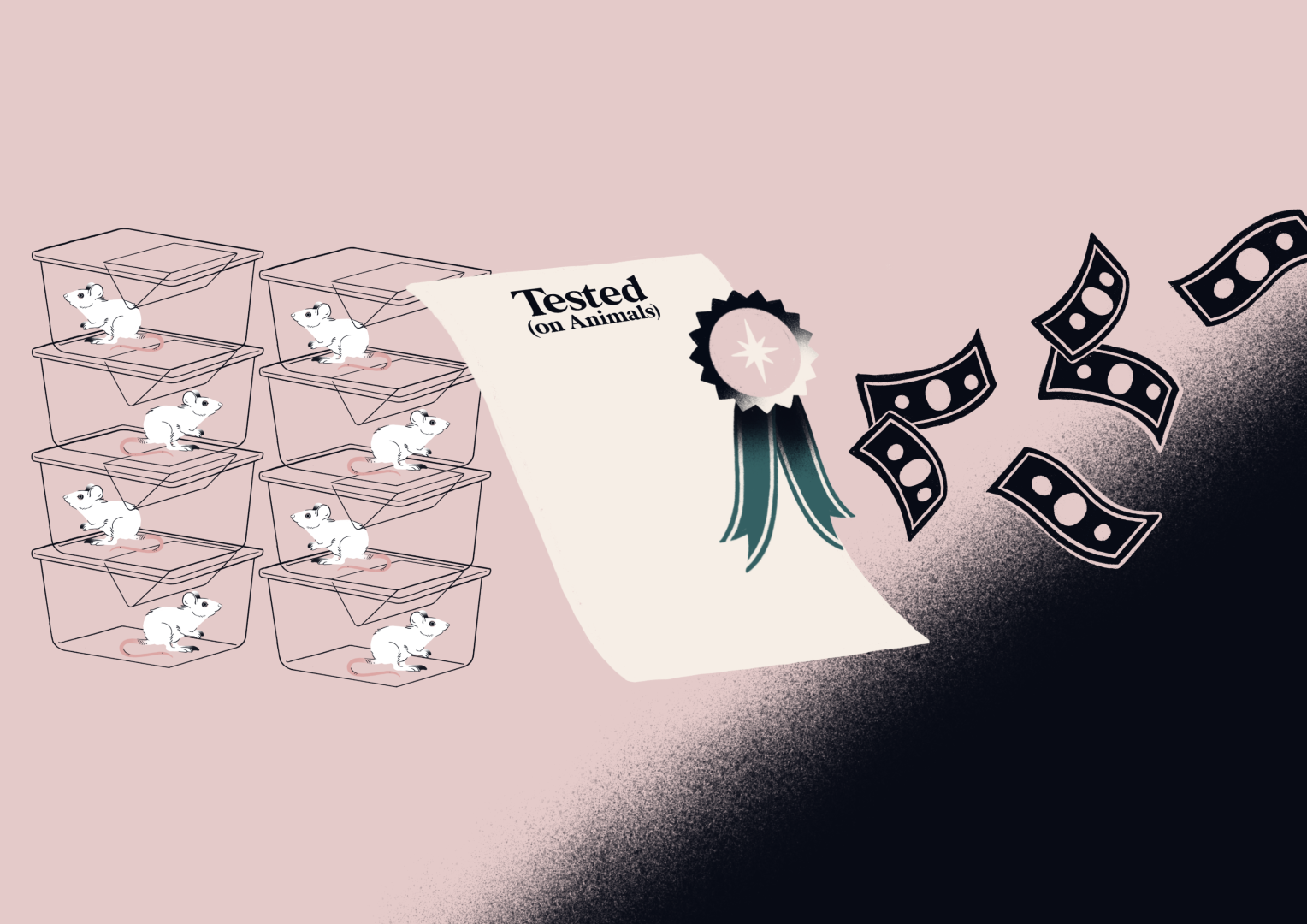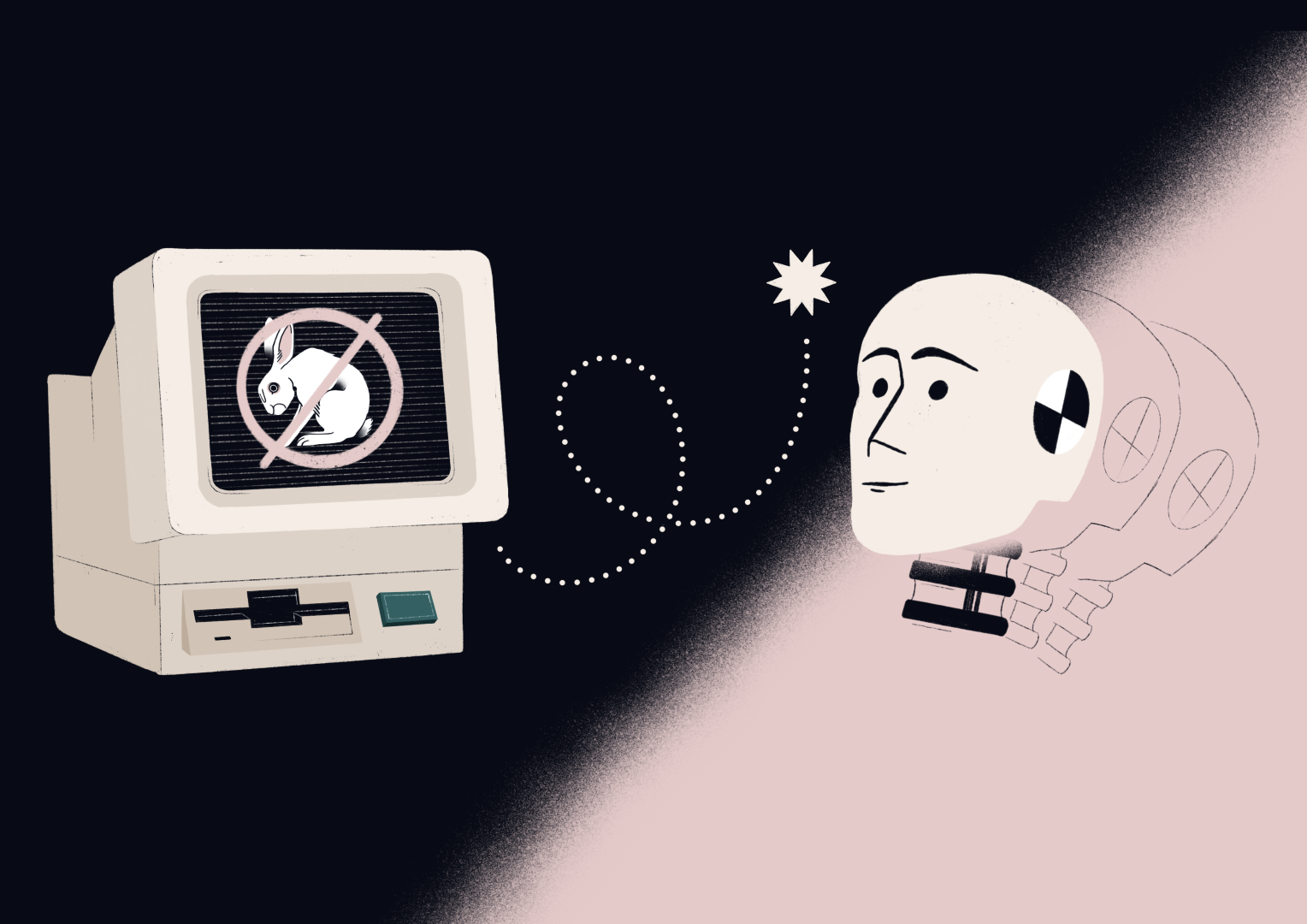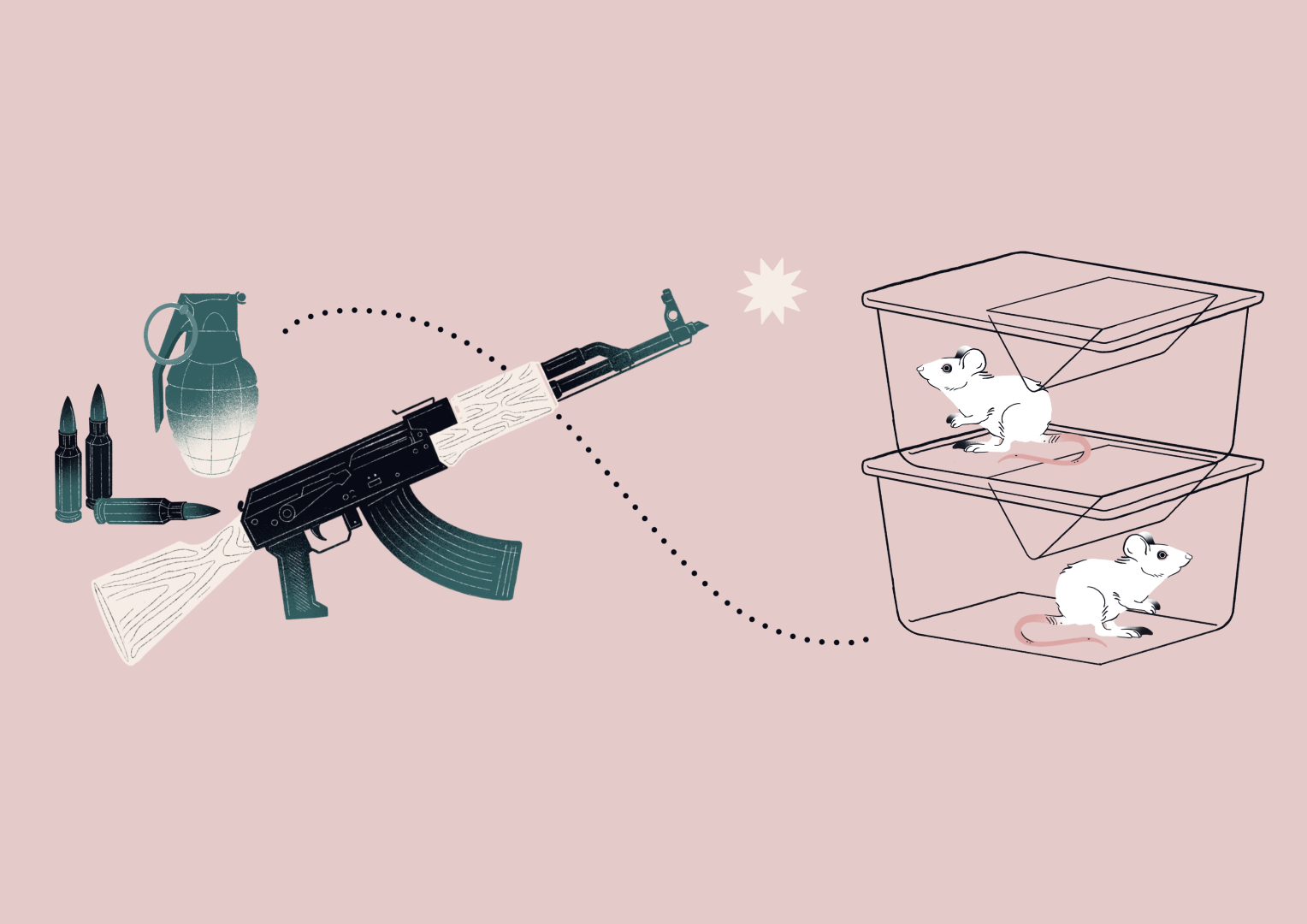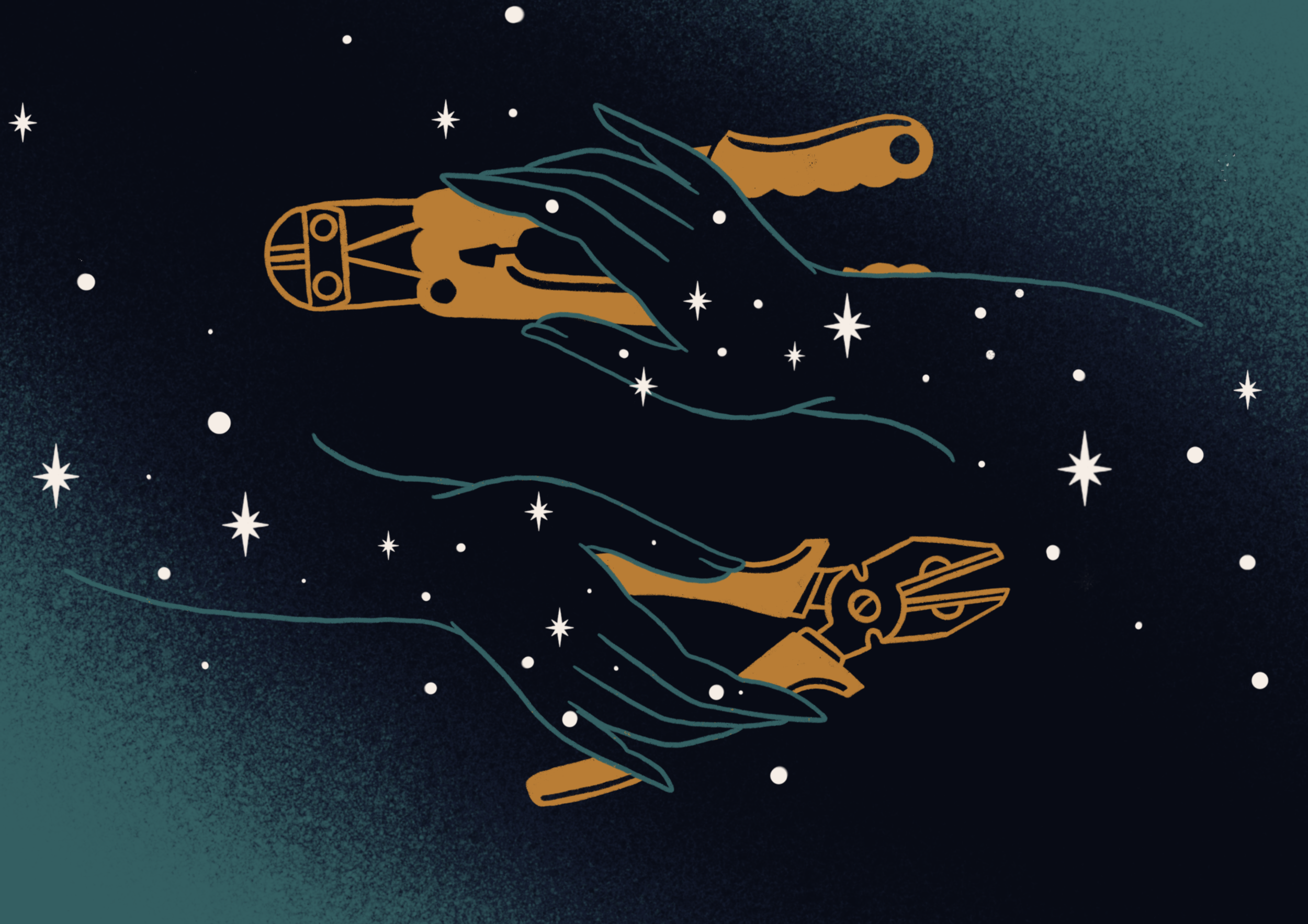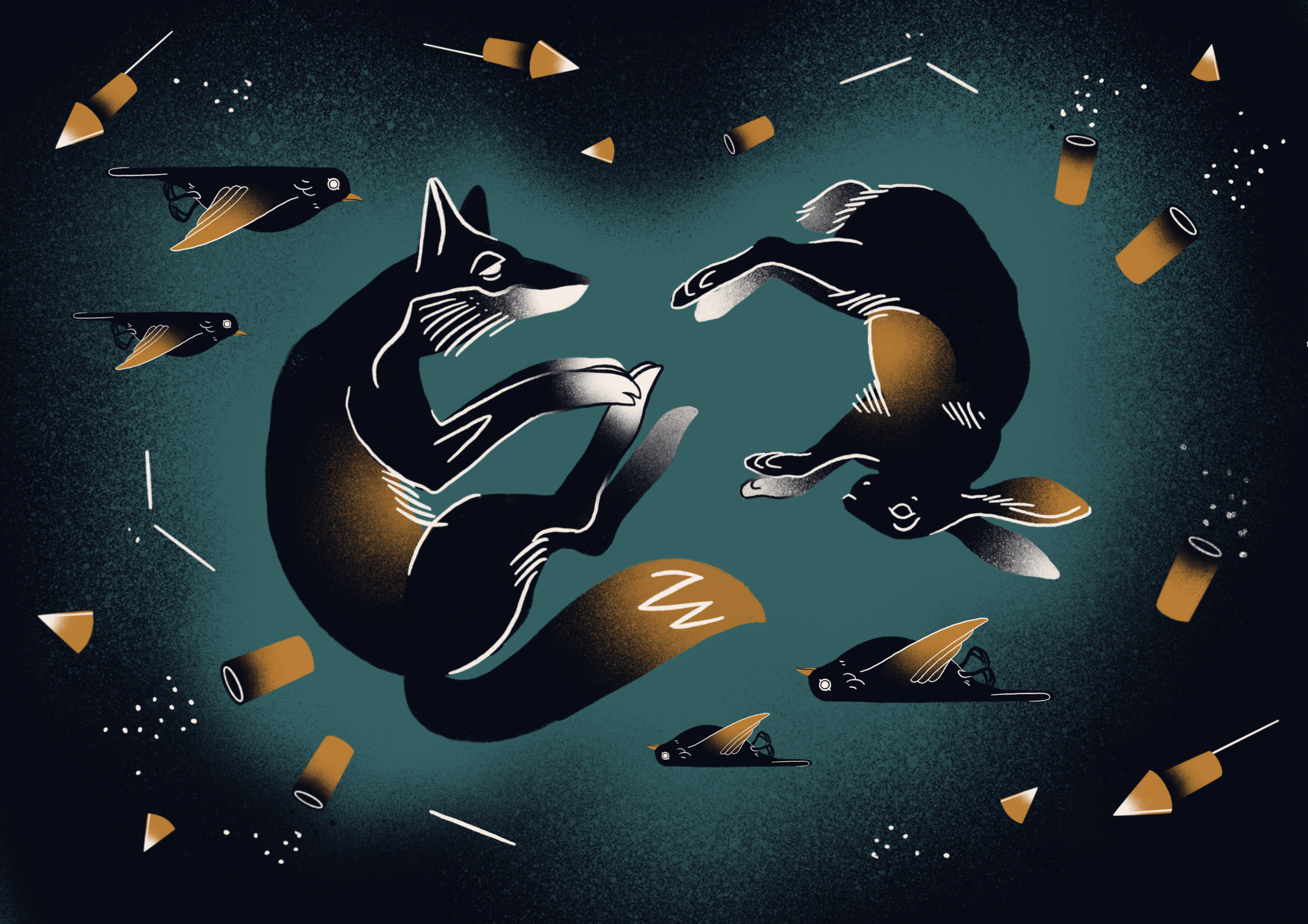THE CRUELTY AND ABSURDITY OF ANIMAL TESTING & EXPERIMENTS
Animal testing is all around us, so it seems and so it is. The subject of animal testing is a very complex and at the same time very intransparent subject, which clings to legal loopholes and does anything to prevent images as well as information from getting out to the public. Why? There is a lot of money at stake in this industry. The pharmaceutical industry, politics, the media amongst other industries also profit from animal testing, so they try to hide and justify it.
In this blog post, we will shine a light on this horrific and disgusting industry and will look at modern and up-to-date methods you may not even know about yet. So feel free to share this blog post with anyone you know!
We’ll cover the following topics:
The history of animal testing (short version)
Victims of animal testing
The different types of animal testing
Current outlook
Why animal experiments are performed at all?
An outdated and dangerous method
Areas with the most animal experiments
Non-animal testing (focus medical care)
Unbeatable advantages of non-animal methods
Animal testing taxes
Animal testing in cosmetics
Animal testing for cigarettes
Animal testing for pet foods
Animal testing in the automotive industry
Animal testing for art supplies
Animal testing in the military sector
What You can do right now
THE HISTORY OF ANIMAL TESTING (short version)
Animals have been abused repeatedly throughout the history of biomedical research. The idea of animal experimentation arose on one hand from pure curiosity and on the other hand from the desire to be able to conclude humans from experiments on animals.
Early Greek physician-scientists, such as Aristotle (384—322 BC), and Erasistratus (304—258 BC), performed experiments on living animals. Non-human animals were used to discover and understand the functions of living organisms. Vivisection (dissection of a living organism) was practiced on human criminals in ancient Rome and Alexandria, but the prohibition of mutilation of the human body in ancient Greece led to reliance on animal subjects.
Aristotle believed that animals lacked intelligence and therefore the concepts of justice and injustice did not apply to them. Theophrastus, a successor of Aristotle, disagreed and rejected the vivisection of animals because they can feel pain like humans and it is an insult to the gods to inflict pain on animals.
The roman physician and philosopher Galen (130—200 AD) recommended that his students vivisect animals “without pity or compassion” and warned that the “unpleasing expression of the ape when it is being vivisected” was to be expected. He gained a great deal of false knowledge through his animal experiments—partly because he transferred the anatomy of the animals he dissected to that of humans. (13)
False knowledge and learned apathy can still be applied today. It shows the lack of knowledge, apathy, and distance from other animals.
The publication of ‘Animal Liberation’ by Australian philosopher Peter Singer in 1975 rallied the animal rights and anti-animal testing movements by popularizing the concept of “speciesism” as analogous to racism, sexism, and other forms of prejudice. In referring specifically to animal experimentation/testing, Singer predicted that “someday...our children’s children, when they read about what was done in laboratories in the twentieth century, will feel the same sense of horror and disbelief…”(12)
VICTIMS OF ANIMAL TESTING
Animal Testing is the hellish reality that millions of animals experience every single day inside laboratories, hidden from the public. They’re mutilated, force-fed drugs, burned, drowned, and tormented in other unspeakable ways before ultimately being killed.
You don’t need to be a behavioral scientist, biologist, or as some claim, a farmer, to know animals and realize that animals have a complex emotional life. They feel pain physically as well as mentally. This is clearly shown in their reaction and behavior with pain. This is undeniable.
Frightened, uncertain, and terror-filled looks of animals on the road and in the slaughterhouse, as well as the cries of fear and pain during experiments (unless they have been anesthetized), speak for themselves.
Suffering is not only directly physically inflicted pain, but also anxiety, fear of loss, stress, terror, discomfort in situations, exhaustion, grief, and hopelessness.
Rabbits, cats, dogs, guinea pigs, micro pigs, monkeys, birds, hamsters, goats, sheep, pigs, mules, cattle, and many other species are used for cruel and fatal animal experiments. According to Cruelty-Free International half a million animals are used to test cosmetics around the world each year—that’s more than 1,369 today alone.(1) That’s just for cosmetics. The Humane Society estimates more than 115 million animals worldwide are used in laboratory experiments for various testings every year.(2)
What about unreported cases?
The actual number of animals used for animal experiments is uncertain, since “surplus” animals are already killed during breeding and “stockpiling” or die during keeping and transport before the actual experiment. The animals that are exploited in laboratories are not bred according to demand but in surplus to have a certain number of animals in stock at any time.(6)
THE DIFFERENT TYPES OF ANIMAL TESTING
All types of animal testing are cruel and involve deliberately inflicted pain and incurable mental and physical wounds. They always lead to death as planned. No limits are set when it comes to the experiments. Everything you can think of and especially what you can’t even imagine is done to sentient individuals against their will for animal testing. A sad, painful, and most horrific existence is pre-programmed.
The animals are usually born in cages and will never feel the grass underneath their feet, paws, hooves, or paws. They are kept in cages made of steel in the most unnatural environment for any living, sentient organism. That alone is the worst thing that can be done to anyone. A life sentence of confinement to serve a purpose that leads to extradition, oppression, pain, and death.
They are also exposed to dangerous substances (injected or forced to inhale or swallow), anesthetized, cut open, or given foreign objects to see what the consequences are.
➸ Watch here, if you are interested in what is done. Trigger Warning!
It is also important to state that “cruelty-free” animal experimentation can still cause animals pain and distress despite regulations.
CURRENT OUTLOOK
Animal testing is outdated and simply cruel, inefficient, ineffective, degrading, and violent. We have fortunately evolved as a human-animal species and have reached a scientific level of information and working that animal testing is only done purely out of curiosity, cruelty, disrespect, apathy, and ignorance of the lives and suffering of others.
In addition to the many reasons listed above, testing on animals is wasteful, unproductive, and speciesist.
“Animal experimentation research is largely exempt from animal welfare rules and laws. There are hardly any limits to the suffering of laboratory animals. Monkeys, dogs, cats, mice, fish, and many other animals are abused and tortured during experiments in the high-security bunkers of the animal testing industry. Whether in toxicology, behavioral or basic research—for cigarettes, cleaning products, or the latest headache or diet pill. Animal testing runs right through our consumption.”, says SOKO Tierschutz in Germany.(3)
Animal testing is not only cruel but also irrelevant in terms of human health.
WHY ARE ANIMAL EXPERIMENTS PERFORMED AT ALL?
Animal experiments have already proven to be misleading and worthless in the past, yet they are still practiced in biomedical science. It starts with studies and is emphasized and sold as the only truth over and over again.
The industry persists in animal testing for other reasons, namely to give consumers a sense of security and confidence in new chemical and pharmaceutical products. Animal testing, therefore, has an alibi function and pretends harmlessness, which is not given.
The tests also serve as legal protection. Furthermore, many other industries such as cage manufacturers, breeders as well as universities, contract laboratories, experimenters, and the pharmaceutical industry benefit from them. A powerful system of oppression and exploitation is present here.
Politics and the media are also permeated by this web. They often report uncritically on animal experiments because they are dependent on the industry’s adverts.
Animal experiments are still very popular because you can prove anything you want with them.
AN OUTDATED AND DANGEROUS METHOD
Although more and more people are becoming aware of the inhumane and unacceptable practices of animal experimentation through the outstanding efforts, exposures, and essential educational work of animal activists, the majority of people are still unaware of the unnecessary and plain wrongness and even danger of animal testing.
It is a fact that animals do not get many of the human diseases that people do, such as major types of heart disease, many types of cancer, HIV, Parkinson’s disease, or schizophrenia.(4) Instead, signs of these diseases are artificially induced in animals in laboratories in an attempt to mimic human disease. Of course, this cannot be compared in any way and treated equally.
These facts alone prove that animal experiments are neither necessary nor helpful, but can even be dangerous to both non-human and human animals!
The association ‘Doctors Against Animal Testing’ (Verein “Ärzte gegen Tierversuche”) states that prospective human medical surgeons usually have to complete exercises on anesthetized pigs. Due to anatomical differences, such surgical exercises are unsuitable and even dangerous, as they are practiced on the wrong ‘object,’ which conveys a false, perceived sense of security among the course participants.(5)
AREAS WITH THE MOST ANIMAL EXPERIMENTS
You may think that most animal testings are done in the cosmetic industry as we always hear about animal testing in connection with it. But the area with the most animal experiments is the drug research and university research. Also in the chemical industry, nutrition, and environmental research, as well as in the context of vaccine testing, disease diagnostics, these cruel experiments are carried out.
An incredible number of animal experiments also take place in basic research, because it is intended to increase general medical and scientific knowledge. The benefit of the experiments does not have to be proven here.
In basic research, the focus is on science itself and not on healing and health. Mere curiosity brings with it an inconceivable number of victims. It is not a matter of new knowledge but of conveying knowledge that has been known for a long time.(6)
NON-ANIMAL TESTING (emphasizing in medical care)
The association ‘Doctors Against Animal Testing’ (Verein “Ärzte gegen Tierversuche”) says “We do not speak of ‘alternative methods’, as this term implies that animal experimentation is in principle a useful method that merely needs to be replaced. Moreover, the term ‘alternative’ includes both animal-free and suffering-reducing methods. However, we are not calling for a mere modification of a wrong system, but for a paradigm shift, i.e. a system change away from animal experimentation as the standard towards modern research-oriented towards humans. Because completely animal-free methods, for example with human mini-organs and multi-organ chips, have scientific value in contrast to animal testing and provide relevant results for humans.”(5)
Nowadays there are already scientifically advanced human cell-based tests and sophisticated computer models that are often quicker, cheaper, more reliable, effective, and transmissible to human animals. Here they are:
human cell research (without fetal bovine serum; read down below)
organ chip technology
multi-organ chip (the 'mini-human') (11)
population studies
microdosing
3D bioprinting
computer simulations (in silico)
➸ Want to know more about those non-animal testings? Check out this page!
Why is this more effective and transmissible?
Between human animals and non-human animals and also among diverse species of non-human animals there are manifold differences regarding physique, organ function, metabolism, nutrition, psyche, and habits. Different animals react differently to various substances and chemicals. I.e. what is harmless for humans can be deadly for animals and vice versa.
What does this mean for animal testing? That they are simply unnecessary and useless.
FETAL BOVINE SERUM (FBS) FOR HUMAN CELL CULTURES (instead of animal testing)
(Addendum; August 25, 2021)
Fetal bovine serum (FBS) is the liquid fraction that remains after coagulation of the blood of a bovine fetus.
Instead of animal experiments, cultures and organ chips made from human cells are increasingly being used, which are i.g. produced as waste during operations. They are used in toxicity testing of chemicals or drug development. To keep these cells alive and make them grow, they need a nutrient medium, i.e. a liquid containing various nutrients. Up to now, blood serum from unborn calves has been the standard medium used for this purpose.
“The collection of fetal calf serum (FBS) is cruel. Immediately after a pregnant cow is slaughtered, her fetus is cut out of the uterus. A thick needle is thrust between the ribs, through the skin and muscles, directly into the beating heart of the still-living calf. The blood is sucked out until the baby is anemic and dies. This procedure is done without anesthesia, although it can be assumed that calf fetuses are already capable of suffering. The worldwide annual demand is about 800,000 liters of fetal calf serum. This means that, according to an estimate by the European Biomedical Research Association, 1—2 million calves per year worldwide have to die in agony in this way.”, says @aerztegegentierversuche (Association against Animal Testing).(19)(20)
Are there animal-free methods?
Yes, there are FBS-free culture media, for example, human platelet lysate (hPL). It’s produced from human platelet extracts obtained from expired blood donations. These are normally discarded.
Many laboratories are inadequately educated about the use of alternative nutrient media and therefore fall back on the “tried and true.”(19)(20)
UNBEATABLE ADVANTAGES OF NON-ANIMAL METHODS
Scientifically well-designed in vitro systems (Latin for “within the glass.” When something is performed in vitro, it happens outside of a living organism) have several unbeatable advantages over animal testing:
No animal exploitation, suffering, and killing
“It is estimated that more than 115 million animals worldwide are used in laboratory experiments every year,” says The Humane Society Global. The dark number is probably a lot higher. These are 115 million sentient lives not being killed for outdated and ineffective testing methods.Reliability
Models based on data or cells derived from humans produce highly reproducible and unambiguous results, which is not possible in animal experiments due to physiological and anatomical differences between humans and animals, among other factors.Sensitivity
In vitro systems are sometimes much more sensitive to toxic influences than live animals.Costs
In vitro systems, once established, are significantly cheaper than animal testing.Duration
Studies using in vitro systems produce results for hours, whereas animal studies can take weeks, months, or even years.Large throughput of test substances
With in vitro systems, a large number of pharmaceuticals or chemicals can be investigated in parallel, e.g. in toxicological studies, whereas the possibilities are limited in terms of numbers with animal-experimental systems.
“Animal-free methods are far more than a mere ‘alternative’ to animal testing. The enormous range of human-based, animal-free research methods makes it possible to obtain reliable findings. This not only spares animals a cruel and unnecessary death in the laboratory but also finally opens up a sustainable path in biomedical research for us humans. The complete phase-out of the animal testing system is urgently needed to clear the way for such well-thought-out, animal-free methods in order not to further block medical progress.”, says Dipl. Biol. Silke Strittmatter, Dr. med. vet. Corina Gericke | February 15, 2021 (5)(6)
ANIMAL TESTING TAXES
Whether we like it or not, we all subsidize animal testing with our tax money without being asked. Just as our tax money flows into the animal industry. Millions of taxpayers’ money go into unnecessary, ineffective, and vile animal testing that is part of government research. This research usually includes pharmaceutical products but the use of animals is also common in pesticide research, medical research, and other experiments.
The majority of animal experiments are part of government research, regulated by “REACH.” REACH (= Registration, Evaluation, Authorisation, and Restriction of Chemicals) is a regulation of the European Union, adopted to ‘improve the protection of human health and the environment from the risks that can be posed by chemicals, while enhancing the competitiveness of the EU chemicals industry.’
It is also interesting and important to know that we participate in the pharmaceutical industry’s animal testing through our health insurance premiums.(6)
Animal testing is everywhere and it happens in secrecy to keep consumers in the dark. The rule of thumb is to question everything and by everything I mean everything.
ANIMAL TESTINGS IN COSMETICS
“If you want to be beautiful, you need to start at your heart”
—Pilar @pilupepper
From skin care products to all kinds of makeup, to perfumes and aftershaves, to shampoo, lotion, and shower gel (also for pet/companion animals), to nail polish and shaving cream…and the list goes on. Animal testing (and animal-derived ingredients) in cosmetics still make a huge market. It is unbelievable that this is still happening as the majority of people at least understand how cruel it is, but aren’t aware that they are still funding it.
If a product is labeled cruelty-free or animal-free, it should generally mean:
no animal testing has been carried out on the ingredients of a product,
no tests were conducted by the brand, and
no tests have been conducted on behalf of the brand (no third-party testing).
Furthermore, it must be taken into account whether a brand is part of a group of companies where ingredients are tested on animals or are commissioned. It’s also of importance that a company doesn’t export to countries, like China, where testing on animals is required by law. Just because it is legally regulated, doesn’t make it okay.
If a product is vegan(-friendly), it should mean that all points above come into force and that a product doesn’t contain any animal products or by-products, such as beeswax, honey, animal fat, lanolin, and carmine (red color from crushed cochineal insects). Look out for an enclosed original and recognized V-label on product packaging, just to make sure.
Can something be vegan but NOT cruelty-free?
No, it can’t, but this is an example of a typical loophole and opportunity exploited by companies that continue to ignorantly test on animals. They cling to the term ‘vegan formular’ (e.g. L’Oreal Botanicals) in the sense of ‘without animal ingredients’, but their products may still have been tested on animals.
According to the logic of the ethical view of veganism, it should also be without animal testing, clearly and without any compromise.
That’s why it’s so important to put the extra minutes into researching a parent company or group of companies to be sure they are not testing on animals. Yes, this can be challenging, but that’s why there are wonderful up-to-date lists out there by dedicated activists.
➸ Here is a list (in German) I go by when I’m looking for detailed information on cosmetic brands, by Daniela from Once Upon A Cream, a dedicated animal activist from Vienna.
➸ Get a detailed explanation and listing of the different official and non-official symbols for vegan and cruelty-free (animal-testing-free) and their meanings, by ethical elephant
Why do companies still test on animals for cosmetics?
Yes, why? Not only is it prohibited by European law, but it is an outdated system ethically, but especially scientifically. In fact, concerning medical progress, animal experimentation is a fatally misleading way to conduct research because it does not provide results that can be reliably transferred to human animals. So why the hell do companies still consciously and fully aware test and therefore exploit, abuse, and kill animals?
In fact, cosmetic products containing raw materials tested on animals may no longer be imported into the EU. However, the bans only apply to ingredients that are used exclusively in cosmetics, and these are about 10% of the substances. The majority is tested on animals according to the requirements of the Chemicals Act, which is also used in the manufacture of chemical products or materials. Animal testing for cosmetics would be very easy to avoid if substances were chosen that are already classified and approved as safe in the cosmetic sector. But the cosmetics industry is all about profit through the latest trends that no one needs and involves countless victims.(6)
Peta International says “Companies are testing on animals to provide data they can use to defend themselves when they are sued by injured consumers. ...Companies use the fact that products have been tested—rather than the actual test results—to support claims that they are conscientious. In most cases, companies settle out of court, preferring to pay the injured consumer rather than bring to light the unreliability of their testing practices.”
Peta2 says “Short answer: Usually, it’s so that they can sell their products in China. …The Chinese government currently requires that all foreign and special-use cosmetics be tested on animals in order to be sold in mainland China. Because of this law, many companies have chosen to pay Chinese government laboratories to torture and kill animals just so that they can make more money by selling products in that country.”
With the statement “we do not conduct any animal testing ourselves. However, animal testing may be mandatory due to the current legal situation in certain countries”, companies are cowardly trying to pass on responsibility in order to preserve their image.
The Humane Society says “When choosing to develop or use new, untested ingredients in their cosmetic products, some companies conduct tests on animals to assess the safety of these new ingredients. This practice is both cruel and unnecessary because companies can create innovative products using thousands of available ingredients that have a history of safe use and do not require any additional testing.”
The loopholes of animal testing in cosmetics. How can companies get away with misleading and deceiving cruelty-free claims?
Companies get away with misleading claims because there are no standard or legal definitions for the term ‘cruelty-free.’ There are no regulations, no monitoring, no check-ups. So companies can use the term in whichever way they like without any consequences or liability, which makes it even harder to sort out the good from the bad.
The animal testing policies of companies that still proceed with this highly outdated and lethal method are filled with loopholes and generic and shady claims to trick their customers into believing their ‘good-will’, for more profits. So be careful!
Know that no company will ever openly admit to ever testing their products on animals because this is of course totally frowned upon. Every single one of us knows the violence that is inflicted on innocent animals when doing so. And so do the people pulling the strings and performing the tests and violence on their victims.(17)
ANIMAL TESTING FOR CIGARETTES
Animal testing, in general, is cruel, despising, and absolutely irrelevant. This should be clear by now. Yet, they are still done as so many aren’t even aware of its distribution and application for certain products. This lack of knowledge benefits companies and industries and costs millions of animals their lives.
SOKO Tierschutz says the following:
“Animal experiments are carried out to test substances in the tobacco and release them for use. This often happens even through government research projects such as the REACH project of the EU. Sometimes tests are also carried out directly by tobacco companies to rebut accusations.
Furthermore, many animal tests are carried out due to the consequences of smoking. This human suffering represents a huge market in research on the consequences of smoking. Animal testing is also required by law by pharmaceutical companies, for the newly developed preparations to combat the consequences of smoking. This is about toxicity, side effects, and ‘safety’.”
Like in any other field where animal testing is done, different animal species exhibit different responses to toxicants. In addition, animals in laboratories are not exposed to cigarette smoke in the same way or in the same time frame as human smokers.(16)
Why is the tobacco industry conducting any more torturous tests on animals?
It seems like a bad joke, but ‘to make smoking less harmful to humans’. Is cigarette consumption worth this suffering on an infinite number of animals? (and your health?)
Nobody likes to hear this, but smoking does not align with a vegan philosophy and attitude to life and way of living. It’s harmful to humans as well as to non-humans, no matter what.
ANIMAL TESTING FOR PET FOODS
No, we are not only talking about general taste tests but torturous and lethal tests as well.
Hardly any animal caretaker (‘keeper’) is aware that countless dogs, cats, guinea pigs, rabbits, horses, sheep, pigs, birds, and many other animals have to suffer daily in test laboratories for animal feed.
Why are animal tests done for pet foods?
Animal individuals used in pet food tests serve the purpose of a measuring instrument. Something is put in at the front and it is measured what comes out. The aim is to get the maximum performance out of “livestock” (farmed animals) and secure market advantages by testing new feed compositions on companion (pet) animals.
Therefore those animals are locked in metabolism cages. Metabolism cages are enclosed, partially barred or flat enclosures for laboratory animals such as rodents, rabbits, poultry, cats, dogs, and monkeys to collect feces and urine separately. After a certain time of testing certain foods or ingredients, the animals are deprived of food for an equally specified time and several tissue samples are taken from their intestine under anesthesia. Afterward, the experiments continue with a differently composed feed. For some tests, the animals in laboratories are intentionally harmed and get diseased to test certain pet foods for effectiveness.
Many feed manufacturers maintain animal laboratories abroad or cooperate with foreign universities.
It is not hard to imagine and empathize with the psychological and physical strain this puts on individuals. They have to undergo unbearable pain, suffering and experience a pure lack of control that no one wants to even begin to imagine. Many individuals die because they get abused over and over again for tests that aren’t necessary. After all, there are enough pet foods out there to choose from already.
➸ At this point, I want to say that dogs can easily thrive on a fully plant-based diet. Watch my video here!
ANIMAL TESTING IN THE AUTOMOTIVE INDUSTRY
Animal testing, such as car crash testing where animals were deliberately slammed into walls at high speeds, was widespread in the automotive industry and unknown to the public—that was until PETA got involved (starting in 1991).(9) For some animals, these violent and disgusting tests are still a reality. They are still proceeded at China’s Third Military Medical University.(18)
“Live pigs and dogs are pulverized in these tests, leaving them with broken bones and severe internal injuries before they’re killed and dissected. Using sentient animals in car-crash tests is cruel, archaic, and unjustifiable.”, says Peta.(18)
Also, car manufacturers have carried out exhaust tests on monkeys to prove the alleged ‘harmlessness of exhaust gases’. The monkeys were locked in a chamber and had to inhale diesel exhaust fumes for four hours.(10)
“In an age when computer models and state-of-the-art dummies are the order of the day, they’re still killing innocent animals in the name of science. It’s like something out of the Dark Ages.”
—Dan Mathews, PETA Senior Vice President of Campaigns
ANIMAL TESTING FOR ART SUPPLIES
You probably already see the pattern here. Animal testing is done, as said in the beginning, everywhere and for everything, often unknowingly by the end-consumer. So it happens with art supplies. Most people and especially artists aren’t even aware that their art supplies may contain animal ingredients, to begin with. I think at this point we can begin to understand the scale of animal testing in this world.
“Artists don’t usually think of their work as a final resting place for animal parts. But from sepia (forcibly obtained from squid) and India ink (more crushed bugs) and to oil pastels (fat + beeswax) and charcoal (specifically Bone Black, which lives up to its name), critters’ bodies abound in all manner of art supplies. This isn’t unusual in the context of 21st-century consumerism; animals pop up in all kinds of products beyond meat and leather, especially if one includes those tested for safety on nonhuman “participants.”, says Dylan Kerr from Artnet.(7)(8)
ANIMAL TESTING IN THE MILITARY SECTOR
Animal testing in the military is not uncommon, but no sector conducts it more in secret than the military. Experiments in armaments research are subject to the strictest secrecy, so hardly any information is made public.
Non-human animals are used in times of war, but also in times of “peace”. In some cases, non-human animals are harmed by militaries used for resources and get harmed by weapons in times of conflict due to explosions, fires, chemical weapons, and other weapons used. During the two World Wars, dogs, camels, and donkeys were used as anti-tank machines, loaded with explosives, and then released in a combat zone.
Dolphins have been used as spies, outfitted with cameras, and sent into enemy zones. Some enemy troops, therefore, would kill any dolphin they saw. Dolphins have also been used to kill enemy divers, by having needles with compressed CO2 installed in their snouts.(14)
Cats were used to detect the presence of gas and animals such as horses, elephants, mules, camels, and deers have been used as a means of transport or for fighting in wars (carrying humans or goods). Other uses include pigeons to send messages, dogs, and other animals to detect mines and animals killed for use as food by the military.(15)
… AND THE LIST GOES ON
That’s a lot to take in and process, especially if you’ve gotten to this point in this blog post, it seems pretty hopeless and inevitable.
WHAT YOU CAN DO RIGHT NOW
As you now realize, animal testing is huge and it needs to be shut down, immediately! It should have never happened in the first place. There are a couple of things you can do right now, to help stop this madness of ongoing violence!
Educate yourself on animal rights, veganism, and further on the topic of animal testing, reflect and react!
If you’re already vegan, know that when you know more you can talk about it more confidently and pass on the information to others. This way we can create a circle of information and bring animal testing to an end. If you need more information, check out the sources section down below.
Refuse to support any company that does animal testing!
By doing so, we leverage our collective buying power to send a distinct message that testing on animals for cosmetics is unacceptable, inhumane, and simply cruel and violent.
Get active online or offline in whatever way resonates the most with you!
Any post, any conversation, any recommendations in stores or between friends, brings the issue of cruelty and animal exploitation into focus.Sign petitions against animal testings and laboratories!
Whether you believe in the effectiveness of petitions or not, let me tell you that it is better to invest a few minutes in getting your point across through your signature than not to try at all.Place a donation at a sanctuary!
Vegan animal sanctuaries are so important to support! They take in rescued or abandoned individuals who have been abused in the animal industry and in labs! They provide the forever home these animals need and deserve! Any donation will do because it adds up!
Adopt animals who were rescued from laboratories!
If you are thinking about taking on the responsibility to care for another individual—always adopt, of course, no compromise—also consider adopting someone who was born into and forced to live in laboratories. These innocent beings have been to hell and back, but sure do deserve the best life they would have always deserved! If you can give it to them, it would be amazing!
Discuss vegan medicine with your healthcare professional
…and check out online portals for more information. If you need life-saving medicine, discuss with your healthcare professional if there are vegan substances with the same effect. Ask for Generic and pioneer products, which contain exactly the same ingredients in the same concentration and are manufactured in the same way. This means no animal studies are required.
➸ For more information check out this article by The Vegan Society on “Is My Medication Vegan?”
Remember, that no animal experiment will be undone if you forgo medication or medical treatment for a (serious) illness.
Please share this blog post and get the message out there! If you are interested in more details please check out the source list down below.
Empty all cages! Fight for what’s right. Speak up!
~~~~~
NOT YET VEGAN?
Please check out this page and make the change!
Support this educational content!
SOURCES
(1) Cruelty Free International - Which animals are used in cosmetics tests?
(2) The Humane Society - Animal Use Statistics
(3) SOKO Tierschutz - Tierversuche
(4) Cruelty Free International - Arguments against animal testing
(5) Ärzte gegen Tierversuche - “Alternativmethoden” zu Tierversuchen
(6) Corina Gericke, Buch: Was Sie schon immer über Tierversuche wissen wollten”
(7) Peta - Cruelty-free Art Supplies
(8) Artnet - Unsettled by the Dead Animals in Your Paint? Welcome to the World of Vegan Art Supplies
(9) Peta - PETA’s Big Impact! Here’s How We Ended Car-Crash Tests on Animals
(10) Peta - Monkeys Abused in Volkswagen Inhalation Test—Take Action!
(11) Ärzte gegen Tierversuche - Multi-Organ-Chip ein vollständiger Ersatz für Tierversuche?
(12) Peter Singer, Book: Animal Liberation
(13) ProCon.org - History of Animal Testing
(14) National Geographics - Military whales and dolphins: What do they do and who uses them?
(15) Animal Ethics - Military use of animals
(16) SOKO Tierschutz - Rauchen
(17) Ethical Elephant - 5 Lies Your “Cruelty-free” Brand is Telling You
(18) Peta - PETA Takes On China for Smashing Animals in Bloody Car-Crash Tests
(19) Ärzte gegen Tierversuche - FKS-frei - Nährmedien ohne fetales Kälberserum
(20) Peta - Fetales Kälberserum: Ungeborene Kälber für Forschung getötet
Please note:
➸ when the term "human" is used, then human animals are meant by it, and the same applies to the term "animal", who are non-human animals.➸ text and illustrations are intellectual property of Kerstin Brueller. Sharing the content for private purposes is appreciated and always to be provided with a copyright. It is prohibited to copy and share it for commercial purposes. Please contact me for a collaboration, if you are unsure or have any further questions. Thanks for your understanding.➸ I personally care much about symbolism and the meaning of certain shapes and metaphors. The images and interpretations are the representation of my own imagination.➸ I dearly care about an inclusive language. Language is always evolving and I myself learn something new every day.
